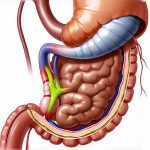Chronic indigestion and persistent nausea are frustrating symptoms that often defy easy solutions. Many individuals experiencing these issues embark on lengthy diagnostic journeys, undergoing numerous tests only to be told their results are “normal” – leaving them feeling dismissed and no closer to relief. While conditions like GERD or anxiety are frequently implicated, a growing body of research points towards a less obvious culprit: chronic low-grade infections. These aren’t the acute, dramatic illnesses we typically associate with infection; rather, they’re subtle, persistent inflammatory responses triggered by microorganisms that may have initially caused an illness but lingered in a dormant state or established themselves in hard-to-reach areas of the body. This can create a cascade of physiological effects, profoundly impacting digestive function and contributing to those debilitating symptoms. Understanding silent reflux is often the first step in finding relief.
The connection between chronic infection and digestive distress stems from the intricate interplay between the gut microbiome, the immune system, and the vagus nerve – often called the “gut-brain axis.” A persistent inflammatory state, even at low levels, disrupts the delicate balance of this ecosystem. It can alter the composition of the gut microbiota, leading to dysbiosis (an imbalance of beneficial versus harmful bacteria). Simultaneously, it overstimulates the immune system, causing a constant state of alert and potentially triggering sensitivities that manifest as digestive symptoms. The vagus nerve, responsible for relaying signals between the gut and the brain, becomes overwhelmed by inflammatory signals, further exacerbating nausea, bloating, and altered motility – the movement of food through the digestive tract. This creates a vicious cycle where infection contributes to inflammation, which then perpetuates the infection and worsens digestive symptoms. In some cases, gut infections can lead directly to these issues.
The Role of Persistent Infections
Chronic low-grade infections can take several forms, each with its own potential impact on digestion. One common source is reactivated viruses, such as Epstein-Barr virus (EBV) or Cytomegalovirus (CMV). These viruses are incredibly prevalent; most people are exposed during childhood and develop immunity – but the virus doesn’t necessarily disappear. It can remain dormant in the body and reactivate under times of stress, immune suppression, or other physiological changes. Reactivation can trigger a low-grade inflammatory response that affects the digestive system. Another culprit is Helicobacter pylori (H. pylori), a bacterium commonly found in the stomach. While often associated with ulcers, even “eradicated” H. pylori infections can leave behind lingering inflammation and altered gut function. Finally, fungal overgrowth, particularly Candida albicans, can contribute to dysbiosis and increase intestinal permeability – often referred to as “leaky gut” – allowing inflammatory substances to enter the bloodstream and exacerbate symptoms. It’s also important to consider whether parasites could be contributing factors.
The impact of these infections isn’t limited to direct inflammation. They also disrupt digestive processes in more subtle ways. For example, chronic inflammation can reduce stomach acid production, impairing protein digestion and increasing the risk of bacterial overgrowth in the small intestine (SIBO). It can also damage the intestinal lining, reducing its ability to absorb nutrients effectively. Furthermore, persistent infections often lead to heightened gut permeability, allowing undigested food particles and toxins to enter the bloodstream, triggering immune responses and further fueling inflammation. This systemic inflammatory state then impacts other bodily functions – including brain function – contributing to fatigue, brain fog, and mood disturbances that frequently accompany chronic digestive issues. Recognizing these subtle connections is crucial for understanding why conventional treatments often fail to provide lasting relief. Understanding how long-term indigestion can impact the esophagus is also key.
Identifying Chronic Low-Grade Infections
Diagnosing chronic low-grade infections can be challenging because standard tests may not always detect them. Traditional antibody testing, for example, only indicates past exposure to a virus and doesn’t necessarily reflect current viral load or active replication. More advanced diagnostic approaches are often needed. – Viral reactivation panels can assess the presence of specific viral proteins indicating ongoing activity – though interpretation requires careful consideration. – Stool tests can identify dysbiosis, fungal overgrowth, and markers of inflammation in the gut. – Breath tests can help diagnose SIBO by measuring hydrogen and methane levels after consuming a specific sugar solution. – Comprehensive digestive stool analysis (CDSA) provides a detailed assessment of digestion, absorption, gut microbiome composition, and immune function.
However, it’s important to remember that test results are just one piece of the puzzle. A thorough clinical evaluation – including a detailed medical history, symptom analysis, and physical examination – is essential for accurate diagnosis and treatment planning. It’s also vital to rule out other potential causes of digestive symptoms through appropriate testing (e.g., celiac disease, food allergies). The goal isn’t simply to identify an infection but to understand how it’s contributing to the patient’s overall symptom picture – and to address the underlying factors that are allowing the infection to persist.
Addressing Infection & Inflammation
Successfully managing chronic indigestion and nausea related to persistent infections requires a multifaceted approach focused on reducing inflammation, restoring gut health, and supporting immune function. – Antimicrobial herbs can be used cautiously under the guidance of a healthcare professional to target specific pathogens – but indiscriminate use can disrupt the gut microbiome further. – Dietary modifications are crucial. An elimination diet can help identify food sensitivities that exacerbate symptoms. A low-FODMAP diet may reduce bloating and gas in individuals with SIBO. Focusing on whole, unprocessed foods rich in anti-inflammatory nutrients is essential.
Beyond directly targeting infection, it’s vital to address the underlying factors contributing to immune dysfunction and inflammation. – Stress management techniques such as meditation or yoga can help regulate cortisol levels and support immune function. – Adequate sleep is essential for immune restoration. – Nutrient supplementation may be necessary to correct deficiencies and support gut healing – but should be guided by testing and a healthcare professional. – Probiotic and prebiotic therapy can help restore a healthy gut microbiome, but choosing the right strains is crucial. Finally, strengthening the gut-brain axis through practices like mindful eating and vagus nerve stimulation exercises (e.g., deep breathing) can improve digestive function and reduce nausea. The impact of gut health extends far beyond digestion.
The Importance of Holistic Care
Chronic indigestion and nausea are often complex conditions with multiple contributing factors. Treating them effectively requires a holistic approach that addresses not only the infection but also the underlying immune dysfunction, gut dysbiosis, and lifestyle factors. It’s essential to work with a healthcare practitioner who understands these interconnected systems – such as a functional medicine doctor or integrative gastroenterologist – to develop a personalized treatment plan tailored to your specific needs. Self-treating can be detrimental, so always seek professional guidance before starting any new supplements or therapies. Remember that healing is not linear; it takes time, patience, and commitment. By understanding the role of chronic low-grade infections in digestive distress and adopting a holistic approach to care, individuals can regain control over their health and experience lasting relief from these debilitating symptoms. Reflux can also contribute to other seemingly unrelated issues.


















